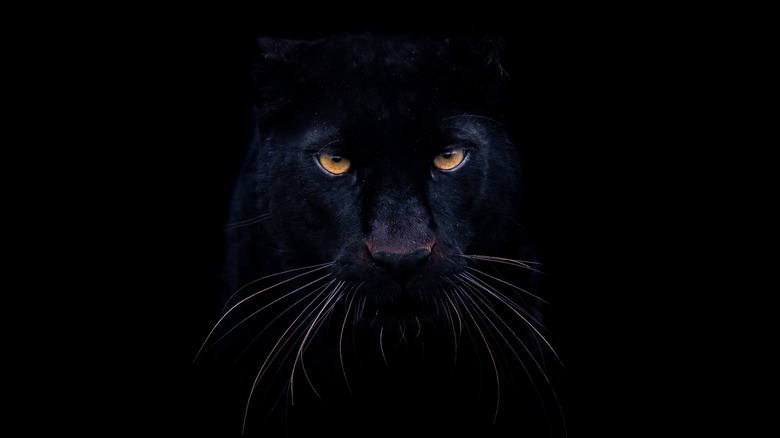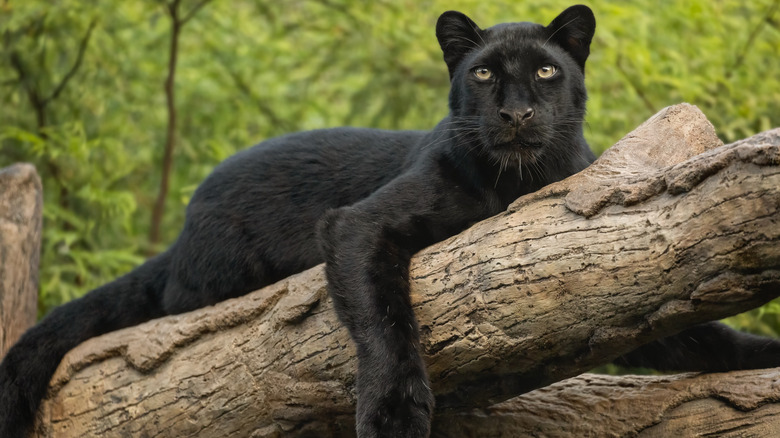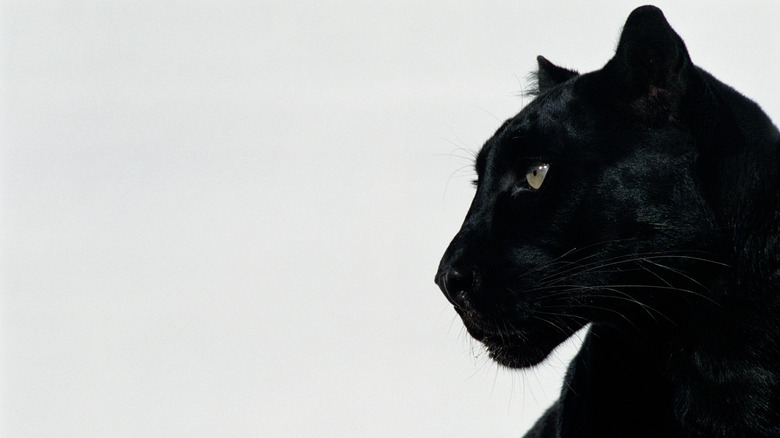Black Panthers Aren't Actually A Species. Here's Why
Boy, cats sure are cute. What with their little paws and their stretching and yawning, or when they bat at one of those cat toys with the feathers on the end. But big cats? Well, so long as they're behind a very sturdy metal fence that also has a very sturdy metal roof, they're beautiful. They're the apex predators of every single environment they inhabit, besides big jerk humans with guns — the cheaters. Maybe that's why big cats can afford to laze around most of the time. There's just nothing to threaten them.
As The Wildlife Diaries explains, there are seven distinct types of "big cats," which doesn't include 33 smaller cat species like lynxes, servals, caracals, and such. Lions get Sub-Saharan Africa, leopards get some bits of Africa and Sri Lanka, jaguars get Brazil and the Amazon, and tigers get the Indian subcontinent. Many of these animals have been at risk from human activity for quite some time, and five cat species are on the IUCN Red List of Threatened Species.
So how about black panthers? Where are they in the mix? Why, they're lighting up box offices when the new Marvel movie comes out, you'd say. But the truth is, black panthers don't get their own category because they're not a separate species. As the Natural Habitat Adventures says, they're just big cats with black fur. More specifically, "panthers" are usually either jaguars or leopards. And a "black panther"? It's a panther of a darker color.
Big and stocky vs. lithe and agile
Before we go further, we've got to do a little recap of binomial nomenclature, the two-part Latin naming system that gives species titles like "Homo sapiens." Cats are mammals, and they eat meat. This means they're in the order Carnivora, as ScienceDirect explains, which includes animals like bears, wolves, wolverines, etc. From there, carnivores break down into smaller groups. We've got the subgroup Feliformia (cat-like carnivores like hyenas and mongooses), the family Felidae (all cats), two subfamilies (Pantherinae, the big cats, and Felinae, the small cats), and finally, individual species like lions, snow leopards, cheetahs, etc. Jaguars have the species name Panthera onca, and leopards Panthera pardus, per The Wildlife Diaries.
In an everyday sense, as we mentioned before, panthers are either jaguars or leopards. As Natural Habitat Adventures details, jaguars look chunkier and stockier (they weigh up to 250 pounds), and leopards look more slender and lithe (their weight generally caps at 175 pounds). Both animals can be black, but jaguars have broader heads and thicker jaws and actually have the strongest bite force of any mammal — they can literally crush skulls and snap necks. Meanwhile, leopards, being smaller and more of a precision weapon, kill prey by clamping on the neck and suffocating its prey. And to clear up any confusion: If you're in Latin America and see a big black cat, it's a jaguar; If you're in Africa, Asia, the Middle East, or Russia, it's a leopard.
A genetic camouflage variation
So if two leopards of equal skill are hunting the same prey at night, and one leopard is spotted, and the other is dark, wouldn't the darker one be harder to detect? Maybe to human eyes. However, both jaguars and leopards have similar, spotted coat patterns that act as camouflage, as The Guardian explains. Cheetahs have spots, too, and they live in different habitats to jaguars and leopards. This is convergent evolution at work: the development of the same characteristics in different species. And black panthers? They also have spotted camouflage — it's just harder to see because their coat is so dark. As Natural Habitat Adventures says, you can spot their spots more easily if the light catches their coats in a certain way.
But why is a black panther black? Simply put, they have more melanin in their skin. Strictly speaking, black panthers are either black or dark brown, per Natural Habitat Adventures. The same genetic variation that affects their skin affects the tint of their hair follicles. The UC Davis School of Veterinary Medicine has a full breakdown of all the genetic combinations of cat coat colors and patterns. The gene in question is called the agouti gene, and it's the same gene responsible for darker coats in other animals like horses, as UC Davis also explains. Not that you could think about any of this if you came face-to-face with a real black panther. You'd be lucky to make it out alive.


